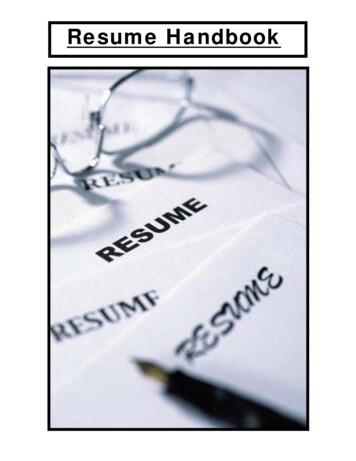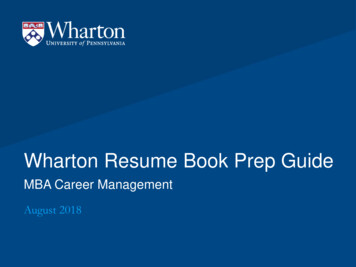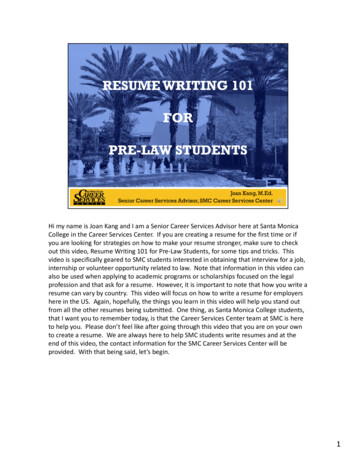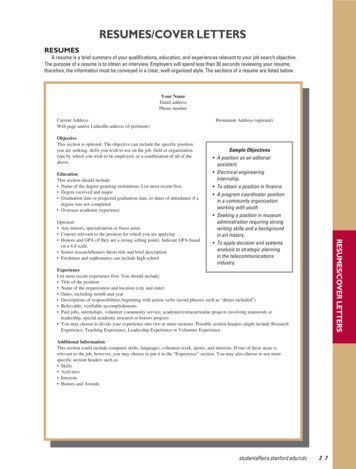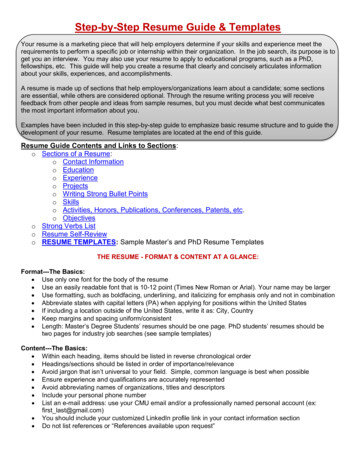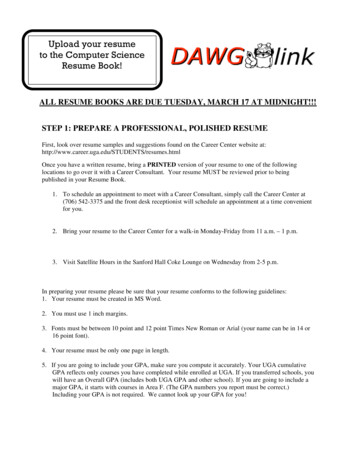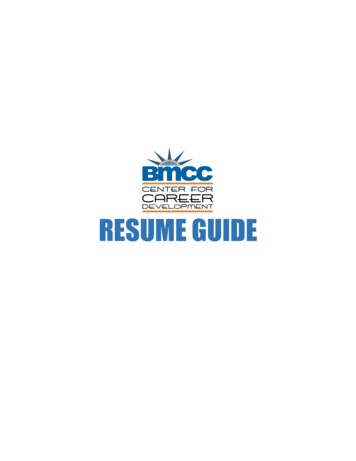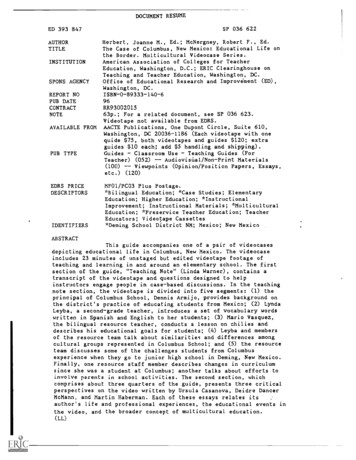
Transcription
DOCUMENT RESUMESP 036 622ED 393 847AUTHORTITLEINSTITUTIONSPONS AGENCYREPORT NOPUB DATECONTRACTNOTEAVAILABLE FROMPUB TYPEHerbert, Joanne M., Ed.; McNergney, Robert F., Ed.The Case of Columbus, New Mexico: Educational Life onthe Border. Multicultural Videocase Series.American Association of Colleges for TeacherEducation, Washington, D.C.; ERIC Clearinghouse onTeaching and Teacher Education, Washington, DC.Office of Educational Research and Improviment (ED),Washington, DC.ISBN-0-89333-140-696RR9300201563p.; For a related document, see SP 036 623.Videotape not available from EDRS.AACTE Publications, One Dupont Circle, Suite 610,Washington, DC 20036-1186 (Each videotape with oneguide 75, both videotapes and guides 120; extraguides 10 each; add 5 handling and shipping).Teaching Guides (ForClassroom UseGuidesAudiovisual /Non -Print MaterialsTeacher) (052)Viewpoints (Opinion/Position Papers, Essays,(100)etc.)EDRS PRICEDESCRIPTORSIDENTIFIERS(120)MF01/PC03 Plus Postage.*Bilingual Education; *Case Studies; ElementaryEducation; Higher Education; *InstructionalImprovement; Instructional Materials; *MulticulturalEducation; *Preservice Teacher Education; TeacherEducators; Videotape Cassettes*Deming School District NM; Mexico; New MexicoABSTRACTThis guide accompanies one of a pair of videocasesdepicting educational life in Columbus, New Mexico. The videocaseincludes 23 minutes of unstaged but edited videotape footage ofteaching and learning in and around an elementary school. The firstsection of the guide, "Teaching Note" (Linda Warner), contains atranscript of the videotape and questions designed to helpinstructors engage people in case-based discussions. In the teachingnote section, the videotape is divided into five segments: (1) theprincipal of Columbus School, Dennis Armijo, provides background onthe district's practice of educating students from Mexico; (2) LyndaLeyba, a second-grade teacher, introduces a set of vocabulary wordswritten in Spanish and English to her students; (3) Mario Vasquez,the bilingual resource teacher, conducts a lesson on chilies anddescribes his educational goals for students; (4) Leyba and membersof the resource team talk about similarities and differences amongcultural groups represented in Columbus School; and (5) the resourceteam discusses some of the challenges students from Columbusexperience when they go to junior high school in Deming, New Mexico.Finally, one resource staff member describes changes in curriculumsince she was a student at Columbus; another talks about efforts toinvolve parents in school activities. The second section, whichcomprises about three quarters of the guide, presents three criticalperspectives on the video written by Ursula Casanova, Deidre DancerMcMann, and Martin Haberman. Each of these essays relates itsauthor's life and professional experiences, the educational events inthe video, and the broader concept of multicultural education.(LL)
THE CASE OF COLUMBUS, NEW MEXICO:Educational Life on the BorderEdited byJoanne M. HerbertRobert F. McNergneyU S DEPARTMENT OF EDUCATIONOnce 01 EduCilhana, nesearn ana improver en!EDUCATIONAL RESOURCES INFORMATIONCENTER (EP ;)This document has bee reproducer] asreceived Iron, ihe pets n or organizationoriginating itMinor changes have seen made toimprove reproduction qualityPools 01 view or opinions staled in thisdocument do nol necessarily represent Alicia! OERI position or polic,MULTICULTURAL VIDEOCASE SERIESA Joint Project of AACTEERIC Clearinghouse on Teaching & TeacherEducation University of Virginia1111AACTEAMERICANNNCrlOF COLLEGESFOR TI ACIt111FMK:A[10NERIC2BEST COPY AVAILABLE
THE CASE OF COLUMBUS, NEW MEXICO:Educational Life on the BorderEdited byJoanne M. HerbertRobert F. McNergneyMULTICULTURAL VIDEOCASE SERIESA Joint Project of AACTEERIC Clearinghouse on Teaching & TeacherEducation University of VirginiaAACTEAMERICANASSOCIAlIONOF COLLEGESFUR TEACHEREDUCATIONERIC
THE CASE OF COLUMBUS, NEW MEXICO:EDUCATIONAL LIFE ON THE BORDEREdited byJoanne M. HerbertUniversity of VirginiaRobert F. McNergneyUniversity of VirginiaAmerican Association of Colleges for Teacher EducationOne Dupont Circle A Suite 610Washington, DC 20036TEL: 202/293-2450 A FAX: 202/457-80954
This publication was prepared with funding from the Office of Educational Research and Improvement, U.S. Department of Education, under contract number RR93002015. The opinions expressed in this report do not necessarilyreflect the positions or policies of OERI or the Department.The American Association of Colleges for Teacher Education is a national, voluntary association of colleges and universities with undergraduate or graduate programs to prepare professional educators. The Association supportsprograms in data gathering, equity, leadership development, networking, policy analysis, professional issues, andscholarship.The opinions, conclusions, and recommendations expressed in this monograph do not necessarily reflect the views oropinions of the American Association of Colleges for Teacher Education. The AACI h does not endorse or warrantthis information. The AACTE is publishing this document to stimulate discussion, study, and experimentationamong educators. The reader must evaluate this information in light of the unique circumstances of any particular situation and must determine independently the applicability of this information thereto.Copies of The Case of Columbus, New Mexico: Educational Life on the Border rriay be ordered from:AACTE PublicationsOne Dupont Circle, Suite 610Washington, DC 20036-1186Single copy for AACTE members/nonmembers: 10Please add 5 for shipping and handlingCopyright 1996 American Association of Colleges for Teacher EducationAll rights reservedPrinted in the United States of AmericaInternational Standard Book Number 0. 89333-140-6
CONTENTSINTRODUCTIONTEACHING NOTEby Linda Warner (The Children's Museum, Boston, Massachusetts)1Case Summary1Transcript of Introductory Comments1Dennis An-nijo, Principal2Lynda Leyba, Second Grade Teacher3Mario Vasquez, Bilingual Resource Teacher5Resource Team6Moving Up and Moving On8Cinco de Mayo9CRITIC AL PERSPECTIVES ON THE CASE:by Ursula Casanova (Arizona State University)11by Deidre Dancer McMann (Albuquerque Public Schools)23by Martin Haberman (University of Wisconsin-Milwaukee)37in
ACKNOWLEDGMENTSWe are grateful for the valuable help we received on this project. We thank the people who contributedtime, ideas, expertise, and financial support.Students, parents, teachers, administrators, and school board members of Deming, New Mexico, PublicSchools allowed us to work in their schools and welcomed us into their homes. We doubt that any representation of their lives, including ours, could fully communicate their sense of community or the depth oftheir generosity.Ernest Skinner, videographer, and Edward Damerel, sound technician, performed the technical work onthe videotape. We value their professionalism.David Imig and Elizabeth Foxwell of the American Association of Colleges for Teacher Education took achance on this project. We gave them every opportunity to demonstrate their patience with us, and theyrose to every occasion.Without the support of The Hitachi Foundation and their director of programs, Laurie Regelbrugge, thiswork might not have been undertaken; it certainly would not have been completed. The Foundation, Laurie, and her colleagues have stretched our thinking and changed our professional practice.We assume full responsibility for our work.Joanne M. HerbertRobert E McNergney
ntroductionagain each night. The Deming Public School DisIf you are a stranger in Columbus, New Mexico,and you stop for gas, or to get lunch in one of thetrict pays to educate these children. And manypeople on both sides of the border support thelocal cafes, don't be in too big of a hurry to get outactivity; some are even trying to establish the firstof town. Ask, and someone will tell you where tointernational school district. We think you wouldfind the museum. It will be close by, like everybe hard-pressed to pinthing else in this villagepoint another place inof a few hundred soulslocated three milesthe United States thatnorth of the Mexicoposes more sharplyThevideotapeshowsdefined issues about theU.S. border.educationallifeasitisinthisWhen you go to thenature of publicmuseum, watch the oldeducation and theplace, or at least as we found35mm movie about Panmaintenance and diffuit when we were there.cho Villa and Generalsion of culture.George "Blackjack" PerHere, you will findshing. Villa crossed thetwo cultures separatedborder here in 1916 anddistinctly by a border;shot up the local hoteland a few of its guests.but the ebb and flow of culture across the lineLegend suggests the proprietor cheated him out ofblurs the social-psychological separation. You willsome money, and Villa took it as a personalsee and hear "multicultural education" as it isaffront. The movie's narrator contends the raiddefined through practice in this community. Butmarked the only time in history that a "foreignyou will have to decide how real, how influential,power" invaded the United States. Obviously, thehow efficacious the practice is. You will also findfilm and life itself were conceptualized in simpleryourself wondering about the meaning of "culture"timestimes when soldiers galloped off under theas defined in part by languagea factor of increasbanner of democracy to force foreigners to theiring importance in many of our nation's schools.knees, and terrorists did not fly in, plant plasticThe videotape shows educational life as it is inexplosives in the bowels of the World Trade Centhis place, or at least as we found it when we wereter, and fly out again. Nonetheless, you cannot sitthere. Did people alter their words and deedsin the museum's dark little theater on those hardbecause we pointed a camera in their direction?seats, watch the movie, step out into the lightSure, they probably wanted to put on their bestagain, and perceive life in that part of the world inface. At the same time, we have learned fromquite the same way as you did when you first droveyears of videotaping in schools that the vast majorinto town.ity of people forget we are there after about 15In somewhat analogous fashion, that is what weminutes; by the second day, they have forgottenhope will happen as you work through this videoour names and why we are there. What we end upcase on educational life in Columbus Elementarywith is footage of fairly natural, even ordinary lifeSchool. We want you to imagine yourself in thisin and around schools.place where children cross the international borThis videocase is one of a pairother is "Theder from Mexico to attend public school in theCase of Deming, New Mexico: L. national PubUnited States each morning, and return homelic Education." Deming, a village 30 miles northv
and another talks about efforts to involve parentsin school activities.The teaching note contains many specific questions about the videotape. The questions areorganized into five general categories that encourage people: (1) to perceive problems andopportunities for teaching as they present themselves on the video; (2) to recognize values thatdrive people's actions on the tape; (3) to call uppersonal, empirical, and/or theoretical knowledgerelevant to teaching practice as it might occur inthis situation or in a similar one; (4) to speculateon what actions might reasonably be taken in thesituation; and (5) to forecast likely consequencesof such actions. We think these five types of questions can be used to trigger people to reflect or tothink professionally about educational practice.The teaching note for Columbus Elementary waswritten by Linda Warner, director of teacher services at the Boston Children's Museum. Asdirector, Warner organizes a variety of professionaldevelopment programs for classroom teachers .Before assuming this position, Warner directed themuseum's Multicultural Education Project forclassroom teachers in grades kindergarten througheight. Warner has a bachelor's degree in sociologyfrom Simmons College and a master's degree ineducation, with an emphasis in teaching English asa Foreign Language, from the University of Michigan. She taught for five years in Massachusetts'spublic elementary schools during the 1970s, a timewhen there was an influx of immigrants from Puerto Rico into the community. Warner also taughtEnglish as a foreign language in Taiwan, China,and japan. After her return to the United States,she taught English as a Second Language for eightyears in refugee resettlement and literacy programs,college writing programs, and adult education programs in Boston.Three professional educators wrote critical perspectives. Each is, in her or his own right,eminently qualified to comment on the content ofthis videotape.Ursula Casanova is an associate professor atArizona State University. Her research has centered on policy issues related to education andculture and has been disseminated in such publi-of Columbus, is the location of the junior high,mid-high, and high schools. We have designed thetwo videocases to span the geography and to a certain extent the sociology of the district. We thinkof these cases as slices of lifenot so good as beingthere, but useful devices for broadening and deepening one's view of education.The Elements of a VideocaseThese videocases are typically composed of threecomponents: a videotape of unstaged teaching andlearning in a multicultural setting, a teaching notefor an instructor using the videotape, and a writtenset of critical perspectives on the video (Herbert &McNergney, 1995). This particular case conformsto the general model by including: (1.) 23 minutesof unstaged, edited video footage of teaching andlearning in and around an elementary school inColumbus, New Mexico; (2) a teaching notecontaining a transcript of the videotape andquestions designed to help instructors engagepeople in case-based discussions about educationallife in Columbus; and (3) a set of three criticalperspectives on the video written by knowledgeable professionalspeople who compel us to thinkseriously about the situation.After a brief introduction, the videotape isdivided into five segments. First, Dennis Armijo,principal of Columbus School, provides background on the district's practice of educatingstudents from Mexico. Second, Lynda Leyba, asecond-grade teacher, introduces a set of vocabulary words written in Spanish and English to herstudents. She also talks about her background, herknowledge of Spanish, her beliefs about multicultural education, and some of the problems sheencounters in the classroom. Third, MarioVasquez, the bilingual resource teacher, conducts alesson on chiles and describes his educational goalsfor students. Fourth, Leyba and members of theresource team talk about similarities and differences among cultural groups represented inColumbus School. Fifth, the resource team discusses some of the challenges students fromColumbus experience when they go to junior-highschool in Deming, New Mexico. Finally, oneresource staff member describes changes in curriculum since she was a student at Columbus school,cations as Schoolchildren At Risk (Richardson,Casanova, Placier, & Guilfoyle, 1989), ElementarySchool Secretaries: The Women in the Princibal'svi
Office (Casanova, 1991), and Putting Research toWork in Your School (Berliner & Casanova, 1993).Since 1990, Casanova and David Berliner havecollaborated with the National Education Association on the publication of several books directedat bridging the gap between research and practice.Casanova also co-edited with Jay Blanchard AnAnthology of Modern Fiction on School Teaching (inpress). Before assuming her position at ArizonaState University, Casanova was a classroomteacher and a principal.Deidre Dancer Mc Mann is a doctoral student inbilingual education with emphases in writing, literacy/biliteracy, and teacher education at theCollege of Education, University of New Mexico.For the past five years, McMann has also served asthe writing resource teacher on the bilingualresource team at Adobe Acres Elementary School,Albuquerque, New Mexico. Prior to this time,McMann taught for six years in elementary andmiddle schools in Albuquerque. In summer 1991,she was a National Writing Project Fellow, and in1992, McMann was co-director of the year-longRio Grande Writing Project.Martin Haberman, a distinguished professor ofcurriculum and instruction in the School of Education at the University of Wisconsin-Milwaukee,has experience as a classroom teacher in grades 2 ,4, and 6 and as a dean of urban outreach. Duringhis tenure at the university, Haberman has developed several teacher education programs. Inrecent years he has focused in particular on thecreation of alternative certification programs forattracting minorities into teaching and for resolving the continuing shortage of teachers for schoolsin poverty areas. His interview for selecting successful urban teachers is used in cities throughoutoptions below and do not necessarily prefer oneover another. The audience and instructionalobjectives should dictate instructional strategy.Teach One or Two Segments in a SessionThe most common strategy for teaching avideocase in the context of a typical college oruniversity course is to break it into segments andto teach it over two class sessions. The segmentsare denoted by text slides interspersed among thevideo footage. (A numeral in the lower right corner of the screen corresponds to the order in whichtext slides and their accompanying footageappear.) On this videotape, there is a brief introduction followed by five slides:(1) "Dennis Armijo, principal "Armijodescribes the community of teachers and learnersat Columbus Elementary School. He also talksabout goals of the school's bilingual program, parents' expectations, and the home-schoolconnection.(2) "Lynda Leyba, second grade teacher "Leybacalls the roll and then introduces a list of voL:abulary words in both English and Spanish. She asksstudents to read the words chorally and to usethem in sentences. Leyba also explains why shehas organized the lesson in this fashion, and shetalks about some of the challenges she faces as sheplans for instruction.(3) "Mario Vasquez, bilingual resource teacher"Vasquez talks about his background and about hisjob at Columbus School. He also teaches a lessonon chiles to Leyba's students. As he does so, avoice-over reveals some of Vasquez's beliefs aboutteaching.the country. In addition, Haberman has writtenseven books, 45 chapters, and 145 articles, hismost recent book being Star Teachers of Children inPoverty, (West Lafayette, Ind: Kappa Delta Pi).Haberman is a former editor of the Journal ofTeacher Education.(4) "Resource Team"Leyba. Vasquez, and otherstaff members discuss similarities and differences inthe ways parents think about work, education, andchildren's behavior. One staff member also talksabout the importance of being able to speak a student's first language.Some Instructional OptionsWe have designed this videocase to be used indifferent ways. Participants' needs, pressures oftime, and instructors' personal styles make instructional flexibility desirable. We have used all the(5) "Moving Up and Moving On"Staff membeisdiscuss some of the challenges Columbus studentsviiIVBEST COPY AVAILABLE
face when they go to junior high school in Deming, New Mexicoa community about 30 milesfrom Columbus.(6) "Cinco de Mayo"One staff member who,as a child, crossed the border to attend ColumbusSchool, describes how the curriculum has changedover time. She notes in particular that she neverstudied Mexican history or culture and thus feels"cheated." Another staff member talks about theannual Cinco de Mayo festival and its importanceto students and their families.Time required for instruction. We have taughtthis particular case numerous times in two sessions,with each session lasting approximately 1 hour.The time required, however, depends greatly onthe maturity and experience of the class membersand on their willingness to share their thoughts.Rich discussion emanates from good questions andis sustained in an environment where people feelsafe to speak their minds. Generally we find experienced educators have more to say than dobeginners.Group size. We have taught groups varying insize from 6 to 80. A group needs to be largeenough to generate a discussion among membersbut not so large that people fail to have a chanceto speak if they wish to do so. Usually we use acombination of whole-group and small-group discussions. We establish small groups of four to sixpeople, assign a recorder to each group, and havethe small groups report back to the whole group atvarious points in the session.Instructional procedures. Although the orderof the steps below might vary on occasion, as wenote, each represents an important part of a casebased lesson.(1) Post five large sheets of newsprint aroundthe classroorr., each labeled with one of the keywords: FACTS/ISSUES, PERSPECTIVES,KNOWL EDGE, ACTIONS, CONSEQUENCES.(It is a good idea to have a couple of extra sheetsready in case you need the extra writing space.)(2) Provide an overview of the case and explainto students that after they view a portion of thevideo, they will analyze what they have seen andheard by responding to some questions. Reviewthe meanings of the key words that will guide thediscussion.(3) Show the introductory portion of the videotape and the first segment ("Dennis Armijo,principal").(4) Begin discussion of the first segment by asking students to describe what they saw occurring(FACTS/ISSUES). Ask students to addressremaining questions represented by key words.Record students comments on the sheets or assigna recorder to do so. (If you are concerned abouthaving too little time, to keep discussion moving,do not record students' full oral responses; merelyuse key words to guide discussion.)(5) Show a second segment. Ask students toaddress each of the five questions. Record responses on newsprint. If using small groups, appoint arecorder for each group to take notes on people'sresponses and to present the group's ideas to theentire class using a "nominal group" technique.Using this technique, the instructor takes only oneidea from a group at a time and then moves to thenext group for another idea. For instance, theinstructor might say: "Would group one pleaseidentify the single most important issue in the segment of video you just viewed? Remember, giveme only one issue, and then we will move to grouptwo to identify another issue." The instructor goesfrom group to group in this fashion until the ideashave been exhausted.Pull some direct quotations from the critical perspectives. We often make overhead transparenciesof particular pages and highlight selected lines toemphasize with the class. The entire perspectivecan be assigned as homework later.(6) Closure. Ask students to consider: (a) possible explanations for similarities and differences intheir thoughts about the videotape, and (b) reasons for examining a particular alternative way ofthinking about teaching and learning in this situation. Have individual students write about theirthoughts or encourage them to cooperate on asmall-group reaction paper.
tion 5. As students work their way through thecase and learn more about the situation, theinstructor may need to focus less on the first twoquestions (FACTS/ISSUES, PERSPECTIVES)and more on the last three (KNOWLEDGE, alternatives for ACTION, CONSEQUENCES).(4) Introduce students to the concept of a "Professional Perspective." Do so by describing it as oneprofessionally defensible point of view on thevideotape. Provide one or more perspectives anddraw particular attention to the identities of thewriters. Ask what explicit and implicit aspects ofthe writers' backgrounds may bt especially important to understand when interpreting theirremarks. Because of the time required to read oneor more perspectives students will need to examinethem outside of class time.When assigning one or more critical perspectivesyou might choose the one most at odds with yourown point of view. If you do so, you can reinforcethe idea that in education, as in other professions,there are often multiple acceptable points of view.Or you might select any two perspectives and havestudents report on the similarities and differencesbetween them with respect to events viewed anddiscussed during class. Have students file the perspectives for future reference. (5) Invoke closurein the session. Ask students to consider: (a) possible reasons for similarities and differences in theirthoughts about events depicted on the videotape,and (b) the strengths and limitations of the professional perspectives.Teach the Whole Case in One SessionThis strategy is designed to teach the wholevideocase from beginning to end.Time required for instruction. We have taughtthis whole videocase in slightly more than twohours, excluding time for reading expert perspectives. With three hours, there is time to proceedwith a whole-group/small-group approach, discussevents and reflections, and even consider selectedcomments from the expert perspectives. Onceagain, the time required depends on the experi-ence of the studentsmore mature groups oftenbring a wealth of practical knowledge to discussions. We strongly encourage people toexperimentshow the events, frame discussionquestions, take short breaks between such discussions, assign outside reading and writing relevantto a case, return the next day and reflect on theprevious discussions and readings.Group size. We have held case-based sessionswith as few as six people and with as many as 80.When students are organized so they have ampleopportunity to participate in small and/or wholegroups, so they focus on the five key ideas, and somomentum in discussion is maintained, a sessionwill be successful.Instructional procedures. (1) Post five largesheets of newsprint around the classroom, eachlabeled with one of the key words: FACTS/ISSUES, PERSPECTIVES, KNOWLEDGE,ACTIONS, CONSEQUENCES. Explain to students, as in Option #1, that after they view aportion of the videotape, they will think aboutwhat they have seen and heard by responding tofive questions. Review the meanings of key words.(2) Show the introduction and two segments. Askstudents to address each of the five questions. Tosave time, do not record students' responses. (3)Show the li-st two segments; again address the fivequestions, this time recording responses onnewsprint.Note that instructor questions need not proceedin linear fashion. For example, the instructor maydeal with questions 1 and 2, move to question 4,then come back to question 3, and jump to ques-View the Videotape as a DocumentaryAlthough the videotape is designed to be used toencourage the development of people's reflectivepowers through active consideration of the fivetypes of questions as the situation unfolds, theinstructor might run it from beginning to end as adocumentary.Time required for instruction. Showing thisvideotape and holding a brief discussion about itscontents typically takes us about 1 hour-5 minutes to set stage for viewing by providing a briefoverview, 30 minutes to view the video, and about20 minutes or slightly more for discussion.ixtiBEST COPY AVAILABLE
finer points but more often than not agreeing onhow to define problems and opportunities inschools. Involving others in discussions aboutschool life seems worth both the time and effort ifpeople want to build consensus for action in publiceducation.For example, the Columbus case might encourage people with different points of view to air theiropinions about "multicultural education" and tolisten to one another in the process. What evidence do parents accept that education isoccurring, to say nothing of that education beingmulticultural? According to students and their parents, how many and which cultures must influencea program before education might reasonably betermed "multi" cultural? What activities otherthan festivals, cooperative work groups, andassigned readings do school administrators believeteachers should use to promote mutual appreciation of cultures? And so forth.A discussion about multicultural educationamong diverse groups today might well turn toquestions about the many conceptions of "politicalcorrectness," or PC. Do people view multiculturaleducation as a form of PCthat is, as an attemptto apply political criteria for acceptable publicexpression? Or do they think that multiculturaleducation goals and behaviors characterized as PCare honest and reasonable attempts to redress thecasual stigmatization of minorities? Do peoplethink that what is termed PC behavior is just plaingood manners? This videocase will not resolvethese complex problems, but, in the hands of askilled discussion leader, it could be used to examine them carefully and fairly.We do not present the Columbus videocase, andby inference the Deming school system, as a modelto be emulated. Our goal is more modest. Wehope people will think and talk with one anotherabout this slice of life, and in doing so, learn something about the people and the schools in thisplace. Maybe students of the case will begin tosee their own situations in a slightly differentGroup size. Because there is less emphasis onin-class analysis and discussion under this option,group size is relatively unimportant, governedlargely by students' abilities to see and hear thevideotape.Instructional procedures. The videotape can beviewed from beginning to end with no pauses fordiscussion much as one would view a documentaryfilm. To maximize the value of such a viewing, theinstructor should provide background informationon the contents of the tapethat is, foreshadowwhat will be seen and heard. If the instructorwants to focus discussion later on particular issuesor events, he or she should alert viewers to beattuned
George "Blackjack" Per-shing. Villa crossed the. again each night. The Deming Public School Dis-trict pays to educate these children. And many. people on both sides of the border support the activity; some are even trying to establish the first. international school district. We think you would. be hard-pressed to pin-point another place in .




